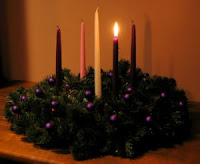Advent
 We often think of Advent as the beginning of the church year. However, the church's calendar is more cyclical than linear. Thus, one does not so much observe a beginning and ending as an ongoing cycle moving from one theme to another. The traditional Advent Wreath may be an appropriate way to illustrate this, as we move toward Christmas by moving in a circle, a symbol of eternity.
We often think of Advent as the beginning of the church year. However, the church's calendar is more cyclical than linear. Thus, one does not so much observe a beginning and ending as an ongoing cycle moving from one theme to another. The traditional Advent Wreath may be an appropriate way to illustrate this, as we move toward Christmas by moving in a circle, a symbol of eternity.One half of the year reflects on the life of the church, the other on the life of Christ. Advent does make us think of beginnings and endings as it points us in anticipation to the end of time and the return of Christ, as well as the birth of Jesus. Yet the best way to think of Advent is to see it in terms of the fulfillment of prophesy. How do we know that Jesus will come again in glory, as He promised? The answer is found in His first coming, the incarnation. In a sense past, present and future are collapsed and made a single whole. As we look back we find assurance to look ahead in hope. The entire story comes together and we see not only the fulfillment of God's purpose from the beginning of time, but we also enjoy the assurance of a future already fulfilled as well. Eternity has broken into time. The church may often be seen as simply repristinating, always trying to live in the past. However, this is far from the truth. The past points us to the future, thus informing how we live in the present.
We often talk about Advent in terms of the various "comings" of Christ. This Sunday's Old Testament lesson from Isaiah 64 offered a great example of this. Bernard of Clairvaux (1090-1153) was the first to talk about the threefold coming: 1.) His visible coming in the incarnation, 2.) His coming into our hearts in an invisible way, and 3.) His coming at the end of time in glory, again in a visible way. Cyril of Jerusalem from the fourth century added a fourth: His coming in the beginning - a birth from God before the ages. Lutherans often talk about a threefold coming similar to Bernard's, yet different. Instead of the invisible coming into the heart they usually speak of His coming in Word and Sacrament. Given the tendency toward becoming overly subjective in matters of the faith, this last scheme seems preferable.
The actual origins of Advent remain obscure. Its entry into the church's calendar comes much later than the other prominent festival times, arriving around the sixth century. Rome was very conservative about this season and resisted it to some degree. The length of the season has varied over time, ranging from four to six weeks. Gregory the Great fixed it at four as symbolic of the 4,000 years of waiting for the Messiah. According to Gregory the world was also created 4,000 years prior to the Messiah.
The penitential aspect of Advent came from Gaul and Spain, although it arrived in Rome only in the twelfth century. Gaul also emphasized the eschatological aspect of the season. This might be a result of the work of Irish missionaries at that time. Although we tend now to accent the hopeful anticipation of the season, historically it seems to have been more penitential in nature, a season much like Lent. Some have thus referred to it as the "Winter Lent." Many of us probably remember that the color of the Advent paraments were always purple/violet, just like Lent. Only recently has the Lutheran church seen blue, a practice borrowed from Sarum use and introduced with the Lutheran Book of Worship in 1978. It just took off from there. Although retaining its Lenten character with the omission of the Gloria and other practices, Advent is also different in that the Alleluia is not technically omitted. The Alleluia is a perpetual song of the church only to be silenced in Lent.
Traditionally the Gospel for the First Sunday in Advent was the Triumphal Entry into Jerusalem. This was eliminated with the revision of the lectionary (but restored again in LSB, as this Sunday testified). Perhaps those who revised the lectionary felt that it was more properly located in the Lenten season. Yet its place in the Advent season showed how the church deals with history. Advent should properly be seen in light of the events of the Redemption as much as the Incarnation. Again, it is about the 'coming' of God among men and what that means in the work and mission of God's Son. As Emmanuel God comes to be with us for the purpose of saving us.
In our current culture Advent can be an awkward season. Christmas songs have been playing at Walmart since Halloween or even before. Yet the church is not ready for Christmas and resists arriving too soon. We also want to prepare for this celebration properly, recognizing that the incarnation is an event far removed from the mystical-magical nature of folklore and the commercial excesses of actual practice. Although it seems as if we are swimming against the current here, it is more necessary than ever. May the Lord use this time to help our people recognize why we even pause to celebrate the birth of God's Son!
The ideas of this post came in large part from notes taken at a summer course entitled "History and Practice of the Church Year" taught by the Rev. Dr. Philip Pfatteicher at Nashotah House.



Comments